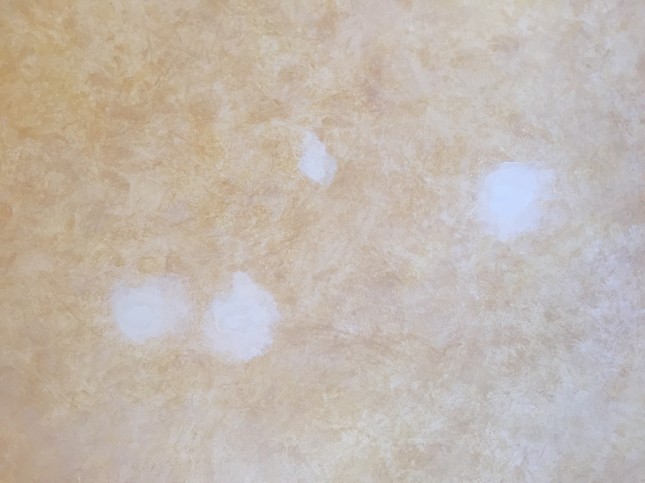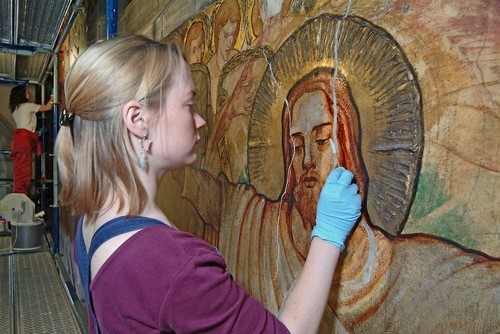Blog Post by Trudy Gaba
 Fearsome Foursome posing around The Throne by Michael Garlington & Natalia Bertotti (located in the Center Hall)
Fearsome Foursome posing around The Throne by Michael Garlington & Natalia Bertotti (located in the Center Hall)
Leave No Trace is one of the top principles regarded amongst the Burning Community—at the close of an event there should be no physical trace of the activities that took place. Such a feat is doable in the vast barren lands of the Black Rock desert; however, the captured essence of Burning Man as an art exhibition that was featured on the grounds and in the galleries of the museum left a few traces after its de-installation in mid-October. The Art of Burning Man was the first museum exhibition dedicated to the artwork of the annual event to be held at the Hermitage Museum and Gardens. Running from June 3 – October 14, 2017, guests were able to experience a bit of that magic playa dust through the large-scale sculptures and interactive installations created by fellow members of the Burner community. The Throne by Michael Garlington and Natalia Bertotti was one of the interactive installations which encouraged guests to sit and playfully pose amongst the patterned backdrop. After the final event, the throne was de-installed, leaving several unsightly holes in need of a little TLC.
 Maeve Bristow, Architectural Conservator, gently sanding the surface of a repaired hole.
Maeve Bristow, Architectural Conservator, gently sanding the surface of a repaired hole.
A couple holes in the wall sounds like no big deal, right? It’s something many of us as home owners and renters have either encountered or accidentally created at some point. A simple run to Home Depot or a quick Yellow Pages search can easily erase that Do-It-Yourself-Project-Gone-Wrong or if we are being completely honest here, a drunken late-night stumble in which elbow met plaster. But for an early 20th century historic house museum, the remedy is not so simple. Repairing the numerous holes left in the surface of the wall from the de-installation of The Throne requires a special phone call to a highly specialized conservator. Maeve Bristow of Black Creek Workshop was kind enough to answer our call.
As a trained art conservator, specializing in architectural painted surfaces and historic interiors, Maeve ensured that the historic interior walls of the Hermitage House would once again regain their marvellous lustre. Maeve was kind enough to chat with me about this restorative process and the current treatments she will be applying to the wall. Before the painting stage can commence, priming, filling, and sanding any holes and cracks must first occur. This helps to ensure a stable surface on which the paint will later be applied.
 Close up of the treatment applied to fill the holes.
Close up of the treatment applied to fill the holes.
 Maeve applying a textured layer of paint with a cloth.
Maeve applying a textured layer of paint with a cloth.
As the above photos illustrate, the wall consists of several different paints that had been applied with textured applications, so Maeve must determine the right paint samples to use that will blend seamlessly with the original paint. Visual analyse also detected a tinted varnish had been used as a finishing coat, which she will also have to match and reapply. The final result proves why Maeve comes highly recommended. There is no visible trace left from the installation process or the subsequent removal of the artwork.
….WANT TO KNOW MORE ABOUT MAEVE?
Maeve hails from the Isle of Mann (I’ll give you a quick moment to google maps it) and her work in historic preservation can be seen all over Scotland, so the next time you are deciding on your vacation destination, trade in those pants for a Scottish kilt and head on over to Bonny Edinburgh. You can polish off a wee pint and walk on up the Royal Mile to check out the stone conservation work she performed at St. Giles Cathedral as well as on the murals of the Mansfield Traquair Trust, which are often referred to as the “Sistine Chapel” of Scotland.
 Maeve Bristow working on the Phoebe Anna Traquair wall paintings in Mansfield Church, Edinburgh.
Maeve Bristow working on the Phoebe Anna Traquair wall paintings in Mansfield Church, Edinburgh.
If a Trans-Atlantic flight isn’t your cup of tea, there are other local opportunities here in Virginia that showcase her work, so pack up the SUV with the family and road trip on over to Mount Vernon to see her restorations on George Washington’s “New Room,” formerly known as the Large Dining Room.
 Maeve working on the ceiling in the New Room at Mount Vernon
Maeve working on the ceiling in the New Room at Mount Vernon
Quick little blurb about the writer who has hijacked the Hermitage’s Collection Blog. My name is Trudy Gaba. I am an alumnus of Norfolk Academy and Virginia Tech (GO H-O-K-I-E-S!), so my fondness for this state runs deep. I’ve recently returned home from a year spent abroad in the UK completing my Master’s Degree in Renaissance and Early Modern Art at the University of Edinburgh. I have a passion for the arts of Asia and Western Europe and will be working at the Hermitage Museum & Gardens as a Curatorial Intern. I’m excited to be collaborating with the head curator, Lindsay Neal, on several upcoming projects she has in the works, so bookmark this page to your favorites and stay tuned for new content and updates!
